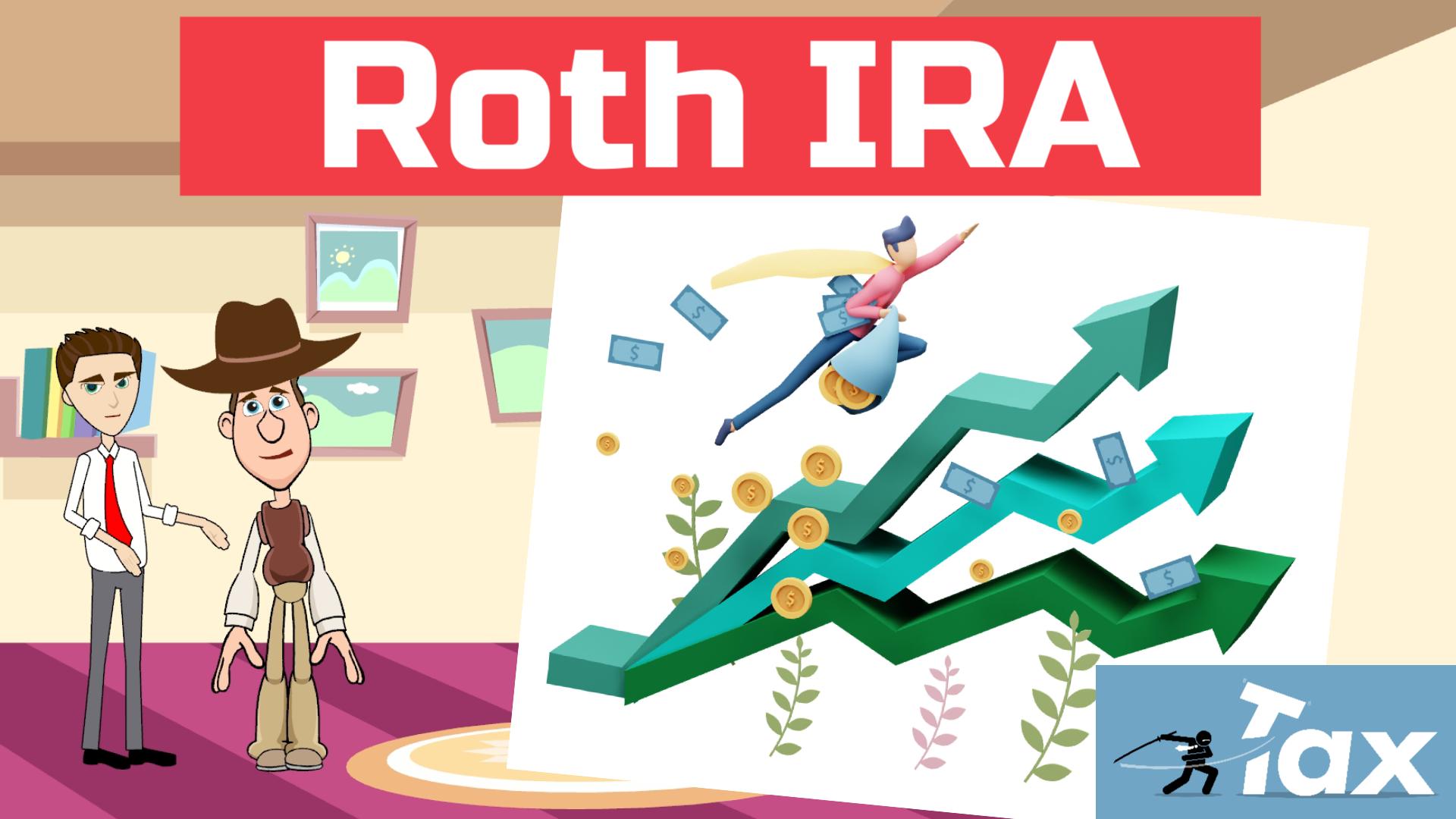Part 1: What is a Roth IRA, How Does it Work, Can Kids have a Roth IRA
Part 2: Advantages of Investing in a Roth IRA, Is a Roth IRA Right for Everyone
Part 3: Disadvantages of Investing in a Roth IRA, Restrictions on Roth IRA Contributions and Withdrawals
Introduction to a Roth IRA for Kids and Teens
This video explains the concept of a Roth IRA in a simple, concise way for kids and beginners. It could be used by kids & teens to learn about Roth IRAs, or used as a money & personal finance resource by parents and teachers as part of a Financial Literacy course or K-12 curriculum.

Suitable for students from grade levels:
- Kindergarten
- Elementary School
- Middle School
- High School
The topics covered are:
- What is a Roth IRA
- How does a Roth IRA work
- Can kids have a Roth IRA
- Benefits of a Roth IRA
- Restrictions on contributions to Roth IRAs
- Restrictions on withdrawals from Roth IRAs
- Other disadvantages of a Roth IRAs
- Is a Roth IRA right for you
What is a Roth IRA?

A Roth IRA is a type of tax-advantaged individual retirement account (IRA) that you fund with money you have already paid taxes on.
This means you don’t get a tax deduction for your contributions, but your money grows tax free and you can withdraw your money – including all the earnings – completely tax-free in retirement.
This is the opposite of a traditional IRA, where you contribute pre-tax money and pay taxes in retirement.
Roth IRAs are a popular option, as anybody can contribute as long as they have earned income and are within the income requirement.
How does a Roth IRA work?
With a Roth IRA, you contribute post-tax earned income, which includes salary, wages, bonus, tips, profit from business, etc. Rent, social security benefits, investment income, alimony, unemployment benefits, etc. don’t qualify as earned income.
The money can then grow in your Roth IRA tax-free, and when you are ready to withdraw the money in retirement, you don’t need to pay any taxes.
Simply opening your Roth IRA will not make your money grow. After you open and fund the account, you will need to choose the securities you want to invest in.
The investment options could be stocks, bonds, Certificate of Deposit (CDs), mutual funds (MFs), index funds, Exchange Traded Funds (ETFs), etc.
Roth IRA can be opened at a bank, credit union or a brokerage that offers IRAs. But brokerages are the more popular choice as they offer a variety of investment options.
Can kids have a Roth IRA?
If your child has earned income, you can open a Custodial Roth IRA for them. Once they turn 18 or 21, they will assume ownership of the account.
This can really help them take advantage of compounding due to the long time horizon, and reap tax benefits especially because they are more likely to be in a higher tax bracket in retirement.
What are the advantages of investing in a Roth IRA?
The biggest advantage of a Roth IRA is the tax free growth and withdrawals.
Unlike a regular brokerage account, where you contribute post-tax money and have to pay taxes when you withdraw, for Roth IRA you only have to pay taxes on the money you contribute.
The money grows tax free, and withdrawals are tax and penalty free so long as they are after age 59 1/2 and the account has been open for at least 5 years.
There are no age restrictions on contributions as long as you have earned income in that tax year.
You have flexibility in timing your contributions – you can contribute your full limit in a single day or spread it out over the year. You also get extra time to contribute – until the tax filing deadline, which is usually April 15th of the following year.

You can fund a Roth IRA along with other tax deferred accounts like 401(k) up to the maximum contribution limits for each one, since Roth IRA has post tax contribution.
There are a variety of investment options – like stocks, bonds, CDs, Mutual Funds (MFs), Exchange Traded Funds (ETFs), etc. – to choose from, based on your investment goals and risk tolerance.
You can withdraw your original contributions at any time tax-free and penalty-free, since you’ve already paid taxes on the contribution.
And the ability to withdraw money before age 59 1/2 penalty-free for certain exceptions makes Roth IRA a great option for unexpected medical emergencies or for paying for college education or buying your first home.
Unlike a traditional IRA, there are no Required Minimum Distributions (RMDs) for a Roth IRA. So if you don’t need the money, Roth IRA becomes a great estate planning tool, as you can simply pass it on to your heirs as a tax-free inheritance.
Even if you are in a higher income bracket and don’t qualify for a Roth IRA, you can use the backdoor Roth IRA option to convert your traditional IRA into a Roth IRA. You just need to pay taxes on the amount you convert, after which you can enjoy all the benefits of a Roth IRA account.
Are there any restrictions on contributions to a Roth IRA?
Yes, there are some restrictions.
Firstly, there is a limit on how much you can contribute to a Roth IRA every year. For 2023, the limit is $6,500, but people over 50 can contribute an extra $1,000 per year.

In addition, there is an income limit for being eligible to contribute. For single filers in 2023, the modified adjusted gross income has to be below $138,000 for the full contribution, and below $153,000 for a reduced amount.
For married filing jointly, the income has to be under $218,000 for the full contribution and under $228,000 for a reduced amount.
The money you contribute also has to be earned income. If your earned income is less than the contribution limit, you can only contribute up to the amount of earned income that year.
Also, the contributions for a tax year must be made before the tax filing deadline, which is usually April 15 of the following year.
Are there any restrictions on withdrawals from a Roth IRA?
You can withdraw your original contributions to a Roth IRA at any time, tax free and penalty free. This is because you’ve already paid taxes on that amount.
However, if you withdraw your earnings before age 59 1/2, you will have to pay a 10% early withdrawal penalty. Although this does not apply if the money is used towards certain qualified expenses such as a first-time home purchase, college education expenses, if the account holder becomes disabled or the assets are distributed to the beneficiary after the account holder’s death.
But no matter your age, if you withdraw less than 5 years after opening the Roth IRA, you will have to pay taxes.
In order to avoid all taxes and penalties, you must have held the Roth IRA for at least 5 years and be over age 59 1/2. Such withdrawals are called qualified withdrawals.
Does a Roth IRA have any other disadvantages?
Unlike most tax-advantaged retirement accounts, you don’t get any upfront tax deduction with a Roth IRA since you have to contribute post-tax earnings.
Also, the contribution limits are much lower than 401(k) and you need to have earned income in that tax year.
There are income limits for being eligible to invest in a Roth IRA. Although a back door Roth IRA conversion is an option for those who earn more than the limit, it can be complicated.
Ultimately, if you expect to be in a lower tax bracket in retirement than you are now, a traditional IRA may be a better option.
So should everyone have a Roth IRA? Is a Roth IRA right for me?
If you are young and just starting your career, you are most likely in a lower tax bracket now than when you’ll retire, making you an ideal candidate for opening a Roth IRA.

Also, when your income increases, you may not qualify for a Roth IRA – but any contributions made now will continue to enjoy years of compounded tax-free growth.
Also, if you plan to work beyond the traditional retirement age, Roth IRA can be very handy as there are no age restrictions on the contributions as long as you have earned income.
Unlike a traditional IRA, Roth IRAs have no Required Minimum Distributions or RMDs. This means you can withdraw the money whenever you want, without needing to withdraw a certain amount every year.
So a Roth IRA is a good choice if you want to leave money to your heirs – in most cases, they won’t have to pay taxes on withdrawals.
So if you meet the eligibility criteria, plan to use the money only in retirement, don’t have access to employer sponsored retirement plans and will likely be in a higher tax bracket in retirement, investing in a Roth IRA is a great choice!
But make sure to consider all possible retirement accounts based on your needs, like 401k account.
Download Transcript: Ideal for Use by Teachers in their Lesson Plan to Teach Kids & Teens
Part 1: What is a Roth IRA, How Does it Work, Can Kids have a Roth IRA
Part 2: Advantages of Investing in a Roth IRA, Is a Roth IRA Right for Everyone
Part 3: Disadvantages of Investing in a Roth IRA, Restrictions on Roth IRA Contributions and Withdrawals

